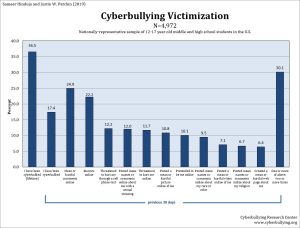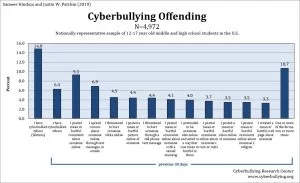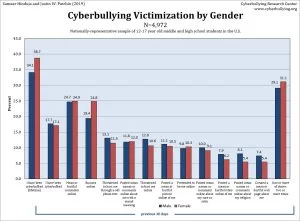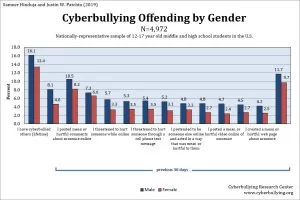This study surveyed a nationally-representative sample of 4,972 middle and high school students between the ages of 12 and 17 in the United States. Data were collected in April of 2019. Click on the thumbnail images to enlarge.
Cyberbullying Victimization. We define cyberbullying as: “Cyberbullying is when someone repeatedly and intentionally harasses, mistreats, or makes fun of another person online or while using cell phones or other electronic devices.” Approximately 37% of the students in our sample report experiencing cyberbullying in their lifetimes. When asked about specific types of cyberbullying experienced in the previous 30 days, mean or hurtful comments (24.9%) and rumors spread online (22.2%) continue to be among the most commonly-cited. Thirty percent of the sample reported being cyberbullied in one or more of the twleve specific types reported, two or more times over the course of the previous 30 days.
Cyberbullying Offending. We define cyberbullying as: “Cyberbullying is when someone repeatedly and intentionally harasses, mistreats, or makes fun of another person online or while using cell phones or other electronic devices.” Approximately 15% of the students in our sample admitted to cyberbullying others at some point in their lifetime. Posting mean comments online was the most commonly reported type of cyberbullying they reported during the previous 30 days (9.3%). About 11% of the sample reported cyberbullying using one or more of the eleven types reported, two or more times over the course of the previous 30 days.
Cyberbullying by Gender. Adolescent girls are more likely to have experienced cyberbullying in their lifetimes (38.7% vs. 34.5%). This chahnges when reviewing experiences over the previous 30 days, where boys are slightly higher. In this sample, boys were more likely to report cyberbullying others during their lifetime (16.1% vs. 13.4%) and in the most recent 30 days (8.1% vs. 4.6%). The type of cyberbullying tends to differ by gender; girls were more likely to say someone spread rumors about them online while boys were more likely to say that someone threatened to hurt them online. As with 2016, boys reported significantly more involvement in every type of cyberbullying offending behavior we asked about. In the past, this has varied by type of behavior.
Methodology
For this study, we contracted with two different online survey research firms to distribute our questionnaire to a nationally-representative sample of middle and high school students. We had two different versions of our survey instrument which allowed us to ask a variety of questions to subsamples of each group. All students were asked questions about experiences with bullying and cyberbullying, digital self-harm, sexting, and sextortion. Overall we obtained a 15% response rate, which isn’t amazing, but is higher than most generic Internet surveys.
With any imperfect social science study, caution should be used when interpreting the results. We can be reassured somewhat in the validity in the data, however, because the prevalence rates are in line with results from our previous school-based surveys. Moreover, the large sample size helps to diminish the potential negative effects of outliers. Finally, steps were taken to ensure valid responses within the survey instrument. For example, we asked the respondents to select a specific color among a list of choices and required them to report their age at two different points in the survey, in an effort to guard against computerized responses and thoughtless clicking through the survey.
Kenniscentrum Pesten per doelgroep
Stichting Stop Pesten Nu vertrouwt volledig op vrijwillige donaties en de inzet van vrijwilligers om haar belangrijke werk mogelijk te maken. Wij ontvangen geen subsidies, waardoor wij volledig afhankelijk zijn van de steun van mensen zoals u.
Tip van de redactie! Heb je haast? Navigeer dan snel naar:

► Scholen & Professionals Kenniscentrum Pesten in het Onderwijs
- Of navigeer direct naar de informatie per functionaris: Schooldirectie & MT / Anti-pest coördinator / Leerkracht / Mentor / Ouderraad & MR
- Leerlingen & opvoeders: Kinderen & Jongeren (Leerlingen) / Ouders & Opvoeders
► Sportverenigingen Kenniscentrum Pesten in de Sport
- Of navigeer direct naar de informatie per functionaris: Bestuurders / Coaches, Trainers & Begeleiders / (Top)Sporters & Scheidsrechters
- Jonge leden & ouders Kinderen & Jongeren (Leerlingen) / Ouders & Opvoeders
► Werkgevers Kenniscentrum Pesten op het Werk
- Of navigeer direct naar de informatie per functionaris: Directie en bestuurders / HRM / MT en Leidinggevenden / Medewerkers / Ondernemersraden / Vertrouwenspersonen
► Ouderen Kenniscentrum Pesten in Woonzorgcentra

Breng snel een bezoekje aan ...
► Kenniscentrum (Klassiek) Pesten
► Kenniscentrum Online pesten (cyberpesten)
► Kennisbank & Downloadcentrum o.a. Beleid & Factsheets / Handleidingen / Lesmaterialen / Posters / Wetenschappelijke Onderzoeken
► Ik word gepest, wat kan ik doen








